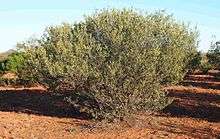Acacia kempeana
| Wanderrie wattle | |
|---|---|
 | |
| Scientific classification | |
| Kingdom: | Plantae |
| Clade: | Angiosperms |
| Clade: | Eudicots |
| Clade: | Rosids |
| Order: | Fabales |
| Family: | Fabaceae |
| Clade: | Mimosoideae |
| Genus: | Acacia |
| Species: | A. kempeana |
| Binomial name | |
| Acacia kempeana | |
 | |
| Range of Acacia kempeana | |
Acacia kempeana (Acacia or ακακία (akakia) from the Greek word Akis for thorn and kempeana after Pastor Kempe, co-founder of Lutheran Mission at Hermannburg-Ntaria in 1877), commonly known as wanderrie wattle, witchetty bush or granite wattle, is a shrub in subfamily Mimosoideae of family Fabaceae. Endemic to Australia, it is widely distributed through arid and semi-arid inland areas of Western Australia, South Australia, the Northern Territory and Queensland.
Description
Wanderrie wattle grows as a spreading shrub with many stems, to a height of about four metres. Like most Acacia species, it has phyllodes rather than true leaves. These are a bright green colour, flat, up to nine centimetres long and 1½ centimetres wide. The flowers are yellow, and held in cylindrical clusters between one and two centimetres long. The pods are papery, about seven centimetres long and 1½ centimetres wide.
Uses
The common name "witchetty bush" refers to the fact that Australian Aboriginals obtain witchetty grubs from the roots. The bush also provides edible gum and seeds.
References
| Wikispecies has information related to Acacia kempeana |
- "Acacia kempeana". Flora of Australia Online. Department of the Environment and Heritage, Australian Government.
- "Acacia kempeana". FloraBase. Western Australian Government Department of Parks and Wildlife.
- Mitchell, A. A.; Wilcox, D. G. (1994). Arid Shrubland Plants of Western Australia (Second and Enlarged ed.). Nedlands, Western Australia: University of Western Australia Press. ISBN 1-875560-22-X.
- Moore, P. (2005). A Guide to Plants of Inland Australia (First ed.). New Holland Publishers. ISBN 978-1-876334-86-4.